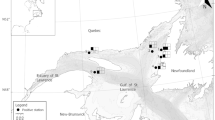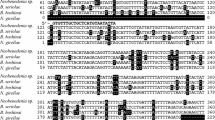Abstract
The Mediterranean fanworm, Sabella spallanzanii Gmelin 1791, was first detected in the Southern Hemisphere in the 1990s and is now abundant in many parts of southern Australia and in several locations around northern New Zealand. Once established, it can proliferate rapidly, reaching high densities with potential ecological and economic impacts. Early detection of new S. spallanzanii incursions is important to prevent its spread, guide eradication or control efforts and to increase knowledge on the species’ dispersal pathways. In this study, we developed a TaqMan probe real-time polymerase chain reaction assay targeting a region of the mitochondrial cytochrome oxidase I gene. The assay was validated in silico and in vitro using DNA from New Zealand and Australian Sabellidae with no cross-reactivity detected. The assay has a linear range of detection over seven orders of magnitude with a limit of detection reached at 12.4 × 10−4 ng/μL of DNA. We analysed 145 environmental (water, sediment and biofouling) samples and obtained positive detections only from spiked samples and those collected at a port where S. spallanzanii is known to be established. This assay has the potential to enhance current morphological and molecular-based methods, through its ability to rapidly and accurately identify S. spallanzanii in environmental samples.

Similar content being viewed by others
References
Capa M, Hutchings P, Aguado MT, Bott NJ (2011) Phylogeny of Sabellidae (Annelida) and relationships with other taxa inferred from morphology and multiple genes. Cladistics 27:449–469
Clapin G, Evans DR (1995) The status of the introduced marine fanworm Sabella spallanzanii in western Australia: a preliminary investigation. Technical Report 2, CSIRO Division of Fisheries, Hobart
Comtet T, Sandionigi A, Viard F, Casiraghi M (2015) DNA (meta) barcoding of biological invasions: a powerful tool to elucidate invasion processes and help managing aliens. Biol Invasions 17:905–922
Currie DR, McArthur MA, Cohen BF (2000) Reproduction and distribution of the invasive European fanworm Sabella spallanzanii (Polychaeta: Sabellidae) in port Philip Bay, Victoria, Australia. Mar Biol 136:645–656
Darbyson E, Locke A, Hanson JM, Willison JHM (2009) Marine boating habits and the potential for spread of invasive species in gulf of St. Lawrence. Aquat Invasions 4:87–94
Darling JA, Mahon AR (2011) From molecules to management: adopting DNA-based methods for monitoring biological invasions in aquatic environments. Environ Res 111(7):978–988
Fletcher LM (2014) Background information on the Mediterranean fanworm Sabella spallanzanii to support regional response decisions. Prepared for Marlborough District Council. Cawthron Institute Report No. 2479A, pp 1–35
Floerl O, Wilkens S, Woods C (2010) Temporal development of biofouling assemblages. Report prepared for the Department of Agriculture, Fisheries and Forestry by the National Institute of Water & Atmospheric Research Ltd., New Zealand, pp 1–47
Geller J, Meyer C, Parker M, Hawk H (2013) Redesign of PCR primers for mitochondrial cytochrome c oxidase subunit I for marine invertebrates and application in all-taxa biotic surveys. Mol Ecol Resour 13:851–861
Giangrande A, Licciano M, Pagliara P, Gambi MC (2000) Gametogenesis and larval development in Sabella spallanzanii (Polychaeta: Sabellidae) from the Mediterranean Sea. Mar Biol 136:847–861
Gillum JE, Jimenez L, White DJ, Goldstien SJ, Gemmell NJ (2014) Development and application of a quantitative real-time PCR assay for the globally invasive tunicate Styela clava. Manag Biol Invasion 5:133–142
Haugland RA, Siefring SC, Wymer LJ, Brenner KP, Dufour AP (2005) Comparison of Enterococcus measurements in freshwater at two recreational beaches by quantitative polymerase chain reaction and membrane filter culture analysis. Water res 39:559–568
Inglis G, Hurren H, Gust N, Oldman J, Fitridge I, Floerl O, Hayden B (2006) Surveillance design for early detection of unwanted exotic marine organisms in New Zealand. Biosecurity New Zealand Technical Paper No. 2005–17
Inglis GJ, Woods C, Willis K, Read G, Seaward K (2008) Incursion response to the Mediterranean Fanworm, Sabella spallanzanii (Gmelin, 1791), in the Port of Lyttelton-Interim Measures. NIWA Client Report: CHC2008–141 prepared for MAF-Biosecurity New Zealand contract 10843, 68
Inglis GJ, Floerl O, Seaward K, Woods C, Read G, Peacock L (2009) Sabella local elimination programme - Phase 1. Final Assessment Report Prepared for MAF Biosecurity NZ Research Project MAF11199:43
Laroche O, Wood SA, Tremblay LA, Ellis JI, Lejzerowicz F, Pawlowki J, Lear G, Atalah J, Pochon X (2016) First evaluation of foraminiferal metabarcoding for monitoring benthic health at an offshore oil drilling site. Mar Environ res 120:225–235
McEnnulty FR, Bax NJ, Schaffelke B, Campbell ML (2001) A review of rapid response options for the control of ABWMAC listed introduced marine pest species and related taxa in Australian waters. Centre for Research on Introduced Marine Pests Technical Report 23, pp 1–99
Morrisey DJ, Depree CV, Hickey CW, McKenzie DS, Middleton I, Smith MD, Stewart M, Thompson KJ (2016) Rapid treatment of vessels fouled with an invasive polychaete, Sabella spallanzanii, using a floating dock and chlorine as a biocide. Biofouling 32:135–144
Mountfort D, Smith K, Kirs M, Kuhajek J, Adamson J, Wood SA (2012) Development of single and multispecies molecular detection methods for the surveillance and monitoring of marine pests in New Zealand. Aquat Invas 7:125–128
Nathan LM, Simmons M, Wegleitner BJ, Jerde CL, Mahon AR (2014) Quantifying environmental DNA signals for aquatic invasive species across multiple detection platforms. Environ Sci Technol 48:12800–12806
New Zealand Government (2006) Biosecurity (Notifiable Organisms) Order 2006 Regulations (SR 2006/320), pp 1–17
New Zealand Government (2010) Biosecurity (Notifiable Organisms) Order 2010 Regulations (SR 2010/265), pp 1–13
O’Brien AL, Ross DJ, Keough MJ (2006) Effects of Sabella spallanzanii physical structure on soft sediment macrofaunal assemblages. Mar Freshw res 57:363–371
Olenin S, Elliott M, Bysveen I, Culverhouse PF, Daunys D, Dubelaar GBJ, Gollasch S, Goulletquer P, Jelmert A, Kantor Y, Bringsvor Mezeth K, Minchin D, Occhipinti-Ambrogi A, Olenina I, Vandekerkhove J (2011) Recommendations on methods for the detection and control of biological pollution in marine coastal waters. Marine Poll Bull 62:2598–2604
Patti FP, Gambi MC (2001) Phylogeography of the invasive polychaete Sabella spallanzanii (Sabellidae) based on the nucleotide sequence of internal transcribed spacer 2 (ITS2) of nuclear rDNA. Mar Ecol Prog Ser 215:169–177
Pochon X, Bott NJ, Smith KF, Wood SA (2013) Evaluating detection limits of next-generation sequencing for the surveillance and monitoring of international marine pests. PLoS One 8:e73935
Pochon X, Wood SA, Keeley N, Lejzerowicz F, Esling P, Drew J, Pawlowski J (2015) Accurate assessment of the impact of salmon farming on benthic sediment enrichment using foraminiferal metabarcoding. Mar Pollut Bull 100:370–382
Read GB, Inglis GJ, Stratford P, Ahyong ST (2011) Arrival of the alien fanworm Sabella spallanzanii (Gmelin, 1791) (Polychaeta: Sabellidae) in two New Zealand harbours. Aquat Invasion 6:273–279
Riding T, Woods C, Wilkens S, Inglis G (2015) Marine surveillance annual report. Surveillance Magazine 42:56–59 http://www.sciquest.org.nz/elibrary/download/111117/Marine_surveillance_annual_report.pdf
R-project (2014) R: a language and environment for statistical computing. R Foundation for Statistical Computing, Vienna http://www.R-project.org
Simberloff D (2003) How much population biology is needed to manage introduced species? Conserv Biol 17:83–92
Simpson TJS, Dias PJ, Snow M, Muñoz J, Berry T (2016) Real-time PCR detection of Didemnum perlucidum (Monniot, 1983) and Didemnum vexillum (Kott, 2002) in an applied routine marine biosecurity context. Mol Ecol Resour doi:10.1111/1755-0998.12581
Smith KF, Wood SA, Mountfort D, Cary SC (2012) Development of a real-time PCR assay for the detection of the invasive clam, Corbula amurensis, in environmental samples. J Exp mar Biol Ecol 412:52–57
Stabili L, Schirosi R, Licciano M, Giangrande A (2009) The mucus of Sabella spallanzanii (Annelida, Polychaeta): its involvement in chemical defence and fertilization success. J Exp mar Biol Ecol 374:144–149
Thompson JD, Higgins DG, Gibson TJ (1994) CLUSTALW: improving the sensitivity of progressive multiple sequence alignment through sequence weighting, position-specific gap penalties and weight matrix choice. Nucleic Acids res 22:4673–4680
Wood SA, Smith KF, Banks JC, Tremblay L, Rhodes L, Mountfort D, Cary CS, Pochon X (2013) Molecular genetic tools for environmental monitoring of New Zealand’s aquatic habitats, past, present and the future. New Zeal J mar Fresh 47:90–119
Zaiko A, Martinez JL, Schmidt-Petersen J, Ribicic D, Samuiloviene A, Garcia-Vazquez E (2015) Metabarcoding approach for the ballast water surveillance – an advantageous solution or an awkward challenge? Marine Poll Bull 92:25–34
Zaiko A, Schimanski K, Pochon X, Hopkins GA, Goldstien S, Wood SA (2016) Metabarcoding improves detection of eukaryotes from early biofouling communities: implications for pest monitoring and pathway management. Biofouling 32:671–668
Acknowledgements
This work was funded by NIWA under Coasts and Oceans Research Programme 6, Marine Biosecurity (2015/16 SCI). We thank Barrie Forrest and Grant Hopkins (Cawthron) and Chris Woods (NIWA) for native Sabellidae collection, Fiona Gower (Cawthron) for taxonomic identification of specimens, the National Invertebrates Collection (NIWA, Wellington) for providing S. spallanzanii and native Sabellidae specimens, Janet Adamson and Witold Ming (Cawthron) for technical assistance, and Nathan Bott (RMIT University, Australia) for providing DNA from the Australian polychaetes. We thank Oliver Floerl (Cawthron) for helpful comments on the draft manuscript and Ulla von Ammon and Olivier Laroche (Cawthron) for supplying their unpublished HTS data and DNA extracts for analysis in this study.
Author information
Authors and Affiliations
Corresponding author
Additional information
Responsible editor: Philippe Garrigues
Rights and permissions
About this article
Cite this article
Wood, S.A., Zaiko, A., Richter, I. et al. Development of a real-time polymerase chain reaction assay for the detection of the invasive Mediterranean fanworm, Sabella spallanzanii, in environmental samples. Environ Sci Pollut Res 24, 17373–17382 (2017). https://doi.org/10.1007/s11356-017-9357-y
Received:
Accepted:
Published:
Issue Date:
DOI: https://doi.org/10.1007/s11356-017-9357-y




